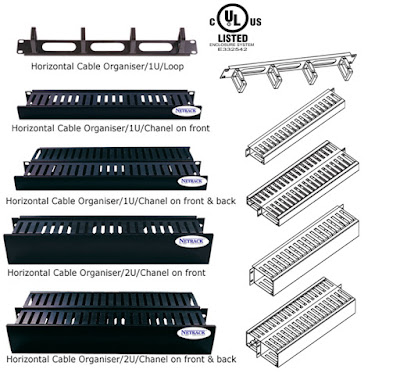Netrack server racks cabinet and Fibre distribution units
Server racks
cabinets are not unlike a server rack in that it contains and organizes IT
equipment. The main distinction between the two is that the server cabinet is
securely enclosed. Implying it has doors at the front and rear of the rack;
these doors are generally perforated in order to increase air circulation
within the enclosure. A server rack cabinet offers additional security due to
the locking component, restricting any kind of tampering. A rack is used to hold and organize IT equipment
in a system that is best for the optimization of the equipment and optimal
utilization of floor space. Generally a “U” space (usually called a Rack Unit
or RU) is a unit of measure and IT jargon for IT equipment. One single U space
amounts to 1.75 inches. Spacing of holes for a standard 19” rack is made in
groups of three holes, these three-hole groups are defined as a 1 U space. Now
a server is a device designed categorically to process requests from other
programs and equipment and deliver that data through the internet or local area
network. Servers execute several different functions including making various
computations for clients or data sharing. In its most crude definition, a
server is a high powered, high functioning, piece of machinery that pushes and
pulls data between the clients and itself.
Data centres these
days consist of rows upon rows of server racks and network cabinets to support
a humongous load of data cables, network devices and power cords. To provide
proficient cable management within confined and tightly-spaced server racks is
quite challenging. But, cable management is no longer a challenge if you stick
to some basics and work with some tried and tested tools.
Within today’s fibre global
environment, multiple service providers demand greater bandwidth for their
subscribers. The technical people require consistent evolution that makes it
easier and more cost-effective for them to build critical fibre connections to deliver gigabit access speeds. The
best way engineers can accomplish this is to deploy fibre distribution units. This is an
enclosure that affords connectivity
between fibre optic cables and passive optical splitters in the
outside plant section of the network. It makes it quick and easy for reconfigurations
and service connections and, serves as a testing point for the outside plant
network. When cabinets are built with factory pre-connected feeder and distribution cable stubs, it ensures quick,
easy and dependable field installation. Fibre distribution hubs differ
in size and shape depending on the position in the network and the quantum of
customers needing service. The best technology afforded in the early years
of fibre-to-the-home constrained
manufacturers to large cumbersome metal cabinets. Placing a cabinet on
the ground, in a utility area met with no objection from either the carrier or
the users. Placing these cabinets on specially designed concrete pads or
utility mount poles was a common practice. Reality today is very different. Today,
FDHs are definitely space and cost effective. The markets demand mighty
subscriber numbers, a tinier footprint and a solution for permit restrictions
on above ground of utility equipment. Fibre distribution units are made in
different forms and sizes, and shapes, depending on their placement in the
network. There are outdoor and indoor FDHs. In the outdoor environment, there
are several choices depending on application and quantum of users requiring
service. Often times more than one design will meet the users requirements, so
it important to work with a trusted advisor to determine which is best for your
specific application. Fibre
distribution hubs enable the connection between fibre optic cables and passive
optical splitters in the outside plant segment of the network. A good FDH
provides high-density fibre connectivity to a weatherproof, compact, enclosure
to meet increasingly restrictive permitting ordinances.


Comments
Post a Comment